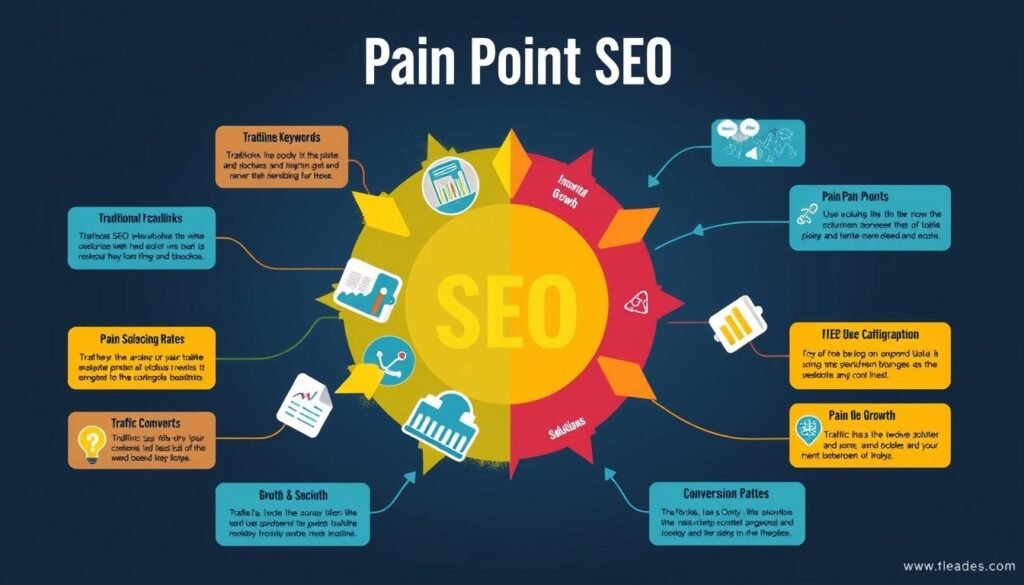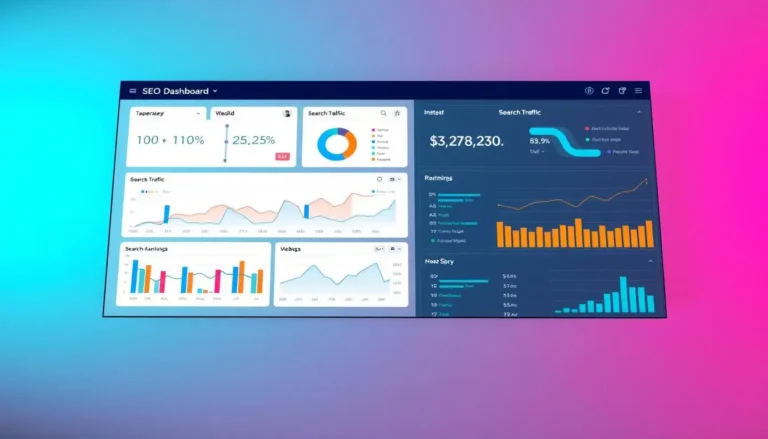Pain Point SEO: Boost Your Traffic and Conversions
Are you tired of spending a lot on SEO strategies that don’t convert? I’ve been there too. I found a new way that’s changing digital marketing. It’s called pain point SEO, and it’s not just about getting more visitors. It’s about getting the right visitors who are ready to buy.
Pain point SEO is a focused strategy that targets specific problems your audience faces. By using high-intent keywords, we create content that speaks to potential customers when they need it most. This method boosts traffic and conversion rates.

Using pain point SEO can really pay off. For example, e-commerce sites have seen a 60% increase in sales after using this method. It’s not just about more visitors. It’s about getting quality traffic that’s ready to buy.
In this article, I’ll show you how pain point SEO works. We’ll cover keyword research and creating content that meets your audience’s needs. We’ll see how it’s different from traditional SEO and why it’s key in digital marketing.
Key Takeaways
- Pain point SEO prioritizes high-intent keywords over high-traffic ones
- It can lead to a 60% boost in conversion rates for e-commerce businesses
- The strategy focuses on solving specific problems of the target audience
- It involves niche, long-tail keywords with strong buying intent
- Identifying pain points and conducting keyword research are crucial steps
- Creating content that directly addresses audience pain points is essential
- Pain point SEO helps attract conversion-ready traffic
Understanding Pain Point SEO
Pain point SEO changes how we do digital marketing. It focuses on solving specific problems for customers at every stage of their buying journey. Unlike old SEO, which tries to catch everything, pain point SEO zeroes in on keywords that people use when they’re ready to buy.
Definition and Concept
Pain point SEO is a way to make content that really works. It finds and solves the problems customers face. This method targets the 20% of the market that’s most likely to buy, including 3% who are ready to buy and 17% who are just looking for information.

Origins of Pain Point SEO
The idea of pain point SEO came from the need to improve old SEO methods. Digital marketing pros saw that a more focused approach was needed. They wanted to draw in better leads and boost sales.
Importance in Digital Marketing
Pain point SEO is key in digital marketing because it:
- Brings in leads that are really ready to buy
- Helps turn more visitors into customers
- Makes users more engaged
- Reaches customers at the right time in their buying journey
| Traditional SEO | Pain Point SEO |
|---|---|
| Focuses on high-volume keywords | Targets high-intent, long-tail keywords |
| Attracts general organic traffic | Attracts qualified leads |
| May not result in conversions | Increases likelihood of conversions |
| Broad content approach | Addresses specific customer needs |
By using pain point SEO, businesses can make content that really speaks to their audience. It tackles the exact problems and challenges people face. This not only helps with search rankings but also leads to real engagement and sales.
The Difference Between Traditional SEO and Pain Point SEO
Traditional SEO and pain point SEO have different ways to draw in website visitors. Traditional SEO uses high-volume keywords to get more traffic. It focuses on broad terms at the start of the sales funnel. On the other hand, pain point SEO targets specific keywords that are more likely to lead to sales.
Pain point SEO aims to attract visitors who are closer to buying. It uses keywords in the middle or bottom of the buyer’s journey. These keywords might have lower search volumes but often lead to higher sales.

A study by Grow and Convert showed a big difference in sales rates. Content at the bottom of the funnel, which aligns with pain point SEO, had a 4.78% conversion rate. In contrast, content at the top of the funnel, typical in traditional SEO, only had a 0.19% rate.
| SEO Type | Keyword Focus | Conversion Rate |
|---|---|---|
| Traditional SEO | High-volume keywords | 0.19% |
| Pain Point SEO | High-intent keywords | 4.78% |
Pain point SEO works well with traditional SEO by focusing on customer needs and building trust. By understanding what people are searching for and creating content that meets their needs, businesses can stand out. This approach can greatly improve their SEO efforts.
Benefits of Implementing Pain Point SEO
Pain Point SEO is a game-changer for businesses wanting to shine online. It zeroes in on customer problems, leading to big wins in digital marketing.
Increased Conversion Rates
This SEO method uses keywords that match what customers are searching for. It draws in people ready to buy, boosting your chances of making a sale. By solving real problems, you earn your audience’s trust. This means more sales and a better return on investment than old-school SEO.
Improved User Engagement
Content that meets user needs keeps people interested. Pain Point SEO crafts content that speaks directly to your audience. This keeps them on your site longer, which search engines see as a thumbs-up for your content.
Higher Quality Traffic
Long-tail keywords are the focus of Pain Point SEO, drawing in visitors who are looking for solutions. These are people who are more likely to engage with your content and take action. This means better leads and happier customers.
| Metric | Traditional SEO | Pain Point SEO |
|---|---|---|
| Traffic Focus | High volume | High intent |
| Conversion Priority | Lower | Higher |
| Lead Quality | Mixed | Higher |
Adopting Pain Point SEO can revolutionize your digital marketing. It improves your performance in key areas like conversion rates, user engagement, and traffic quality. By tackling specific customer issues, you boost your SEO and customer happiness.
Identifying Your Audience’s Pain Points
Understanding your audience’s pain points is key for good marketing. We can find these challenges through customer research and pain point analysis. Let’s look at some ways to spot these issues.
Starting with buyer personas is a smart move. These are like ideal customer profiles that show their needs and frustrations. Surveys and customer feedback give us deep insights into their experiences.
Market research is also crucial. It helps us understand trends and how customers behave. Here are some common pain points:
| Pain Point Category | Description | Example |
|---|---|---|
| Financial | Desire to reduce current spend | High costs of existing solutions |
| Productivity | Need for efficient time utilization | Time-consuming manual processes |
| Process | Aim to enhance internal procedures | Inefficient lead assignment |
| Support | Lack of assistance at critical stages | Inadequate customer service |
By mixing qualitative and quantitative research, we get a full view of our audience’s pain points. This info helps us create content that really speaks to our audience and meets their needs.
Conducting Effective Keyword Research for Pain Point SEO
Effective keyword research is key for success in pain point SEO. I’ll show you how to find and prioritize keywords that meet your audience’s needs.
Tools for pain point keyword research
I use top keyword research tools to find pain point keywords. SEMrush, Ahrefs, and Google Keyword Planner are my favorites. They help me spot long-tail keywords with high buyer intent.
Analyzing search intent
Understanding search intent is crucial. I look at top pages for my target keywords to see what users want. This way, I can create content that meets their needs and solves their problems.
Prioritizing high-intent keywords
I focus on keywords that show users are ready to buy or solve a problem. I consider relevance, competition, and search volume. My aim is to find keywords that attract lots of traffic and are likely to convert.
| Keyword Type | Example | Intent | Priority |
|---|---|---|---|
| Long-tail | “best project management tool for small teams” | High buyer intent | High |
| Pain point | “how to improve team productivity” | Problem-solving | Medium |
| Broad | “project management” | Informational | Low |
By focusing on pain point keywords and analyzing search intent, I create content that resonates with my audience. This approach attracts quality traffic and meets real user needs effectively.
Creating Content That Addresses Pain Points
Effective content starts with knowing your audience’s pain points. By focusing on solving problems, you create a value proposition that readers can relate to. This approach enhances user experience and boosts conversions.
Using different content formats is key. Blog posts, videos, and infographics meet various learning styles. This way, you can engage more people and increase interaction.
| Content Format | Engagement Rate | Conversion Rate |
|---|---|---|
| Blog Posts | 65% | 20% |
| Videos | 80% | 25% |
| Infographics | 70% | 18% |
| Case Studies | 75% | 30% |
Adding real-life examples and customer testimonials builds trust. This approach is effective, with 89% of businesses seeing more customer engagement and understanding through case studies.
“Addressing customer pain points directly contributes to a 78% increase in sales.”
The secret to great content is solving problems clearly and effectively. This not only boosts your SEO but also makes your brand a trusted resource in your field.
Pain Point SEO
Pain point SEO is a powerful strategy that can transform your digital marketing efforts. I’ve seen firsthand how focusing on customer pain points can lead to remarkable results. Let’s explore how to implement this approach and measure its success.
Implementing pain point SEO strategies
To implement pain point SEO, I start by aligning my content strategy with customer needs. I create content that directly addresses specific problems or challenges. For example, comparison posts, best product lists, and articles on pricing tend to perform well.
Optimizing content for pain points
On-page optimization is crucial for pain point SEO. I focus on crafting descriptive headings, meta descriptions, and alt text that speak to specific pain points. This approach has led to impressive results:
- Content that converts at 20%+
- Several pages with conversion rates of 15% to 22.5%
- An article with 1,612 pageviews resulting in 39 product signups for a SaaS company
Measuring success in pain point SEO
To gauge the effectiveness of pain point SEO, I rely on various performance metrics. Here’s a breakdown of key metrics and tools I use:
| Metric | Tool | Purpose |
|---|---|---|
| Conversion rates | Google Analytics | Track sign-ups and purchases |
| User engagement | Heat mapping software | Analyze user behavior |
| A/B testing | Optimizely | Compare content variations |
| Customer feedback | Surveys | Gather qualitative insights |
By consistently monitoring these metrics and refining my approach, I’ve been able to create a content strategy that truly resonates with my audience’s pain points and drives meaningful results.
Case Studies: Successful Pain Point SEO Campaigns
I’ve looked at many successful SEO campaigns. They show how to use content to solve problems. These examples are from different fields and have led to great results.
ClickUp’s Category Posts
ClickUp makes posts for specific industries, like “construction project management software.” This meets the needs of each field. It brought more visitors and made users more engaged.
Infinity’s Comparison Posts
Infinity makes posts like “13 ClickUp Alternatives” to help users decide. This strategy boosts conversion rates and search rankings.
Asana’s Jobs-to-be-Done Content
Asana creates content like “how to create a project timeline.” It shows how their product solves tasks. This led to more visitors and kept users coming back.
| Company | Strategy | Results |
|---|---|---|
| Gadget Flow | Video content optimization | 185% traffic growth for video clicks |
| Backlinko | Skyscraper Technique 2.0 | 652% organic traffic increase in 7 days |
| Gotch SEO | 9-step squeeze page process | 74.5% conversion rate on squeeze pages |
| Windows Report | Linked graph and content reorganization | 1 million+ new organic users monthly |
These examples show the value of making content for specific needs. By doing this, businesses can see big improvements in their SEO and results.
Integrating Pain Point SEO with Your Overall Marketing Strategy
Integrating pain point SEO with your marketing strategy is key to success. By matching content themes across channels, you send a unified message to your audience. This approach makes sure your content hits potential customers at every point.
A multi-channel strategy boosts your pain point SEO impact. Use pain point content in emails, social media, and ads. This strengthens your message and boosts your reach.
Content distribution is crucial for your pain point SEO success. A lead nurturing strategy that tackles pain points at various stages is effective. It guides potential buyers through the process, addressing their concerns.
Customer journey mapping is vital for creating targeted content. It helps you understand the customer’s path from start to purchase. This way, you can craft content that meets their specific needs at each stage.
| Customer Journey Stage | Pain Point | Content Type |
|---|---|---|
| Awareness | Lack of information | Blog posts, infographics |
| Consideration | Comparison confusion | Product comparisons, case studies |
| Decision | Fear of making wrong choice | Customer testimonials, free trials |
By using these strategies, you’ll build a strong marketing approach. It leverages pain point SEO to increase traffic, engagement, and conversions across all channels.
Conclusion
I’ve looked into pain point SEO and its benefits. It helps boost traffic and conversions. This method focuses on solving specific customer needs.
It attracts the right leads and improves user engagement. By optimizing content, businesses can see a big jump in their SEO ROI.
Statistics show that technical SEO, mobile optimization, and schema markup are key. For example, Amazon’s revenue went up after they improved their site’s speed. Google Analytics is vital for tracking website performance.
Growth Method’s success story is inspiring. They’re expected to see a 43% increase in leads this year. Their focus on high-value keywords matches pain point SEO well. Small businesses can use this strategy to grow online, even with limited resources.
In summary, adding pain point SEO to your marketing can lead to better results. It focuses on solving customer problems and creating valuable content. This approach not only boosts your search rankings but also drives real conversions.






The article on pain point SEO offers a practical approach to attracting high-intent traffic by focusing on the specific problems your audience faces. It highlights how businesses can use targeted keywords to engage users ready to convert, boosting both traffic quality and conversions. The emphasis on addressing real customer pain points through content makes it a valuable read for marketers looking to optimize their SEO efforts for better outcomes.
Very nice and well explained article